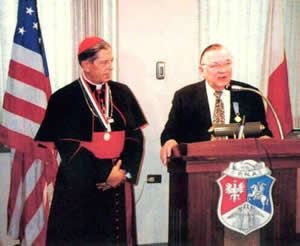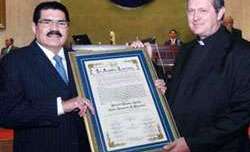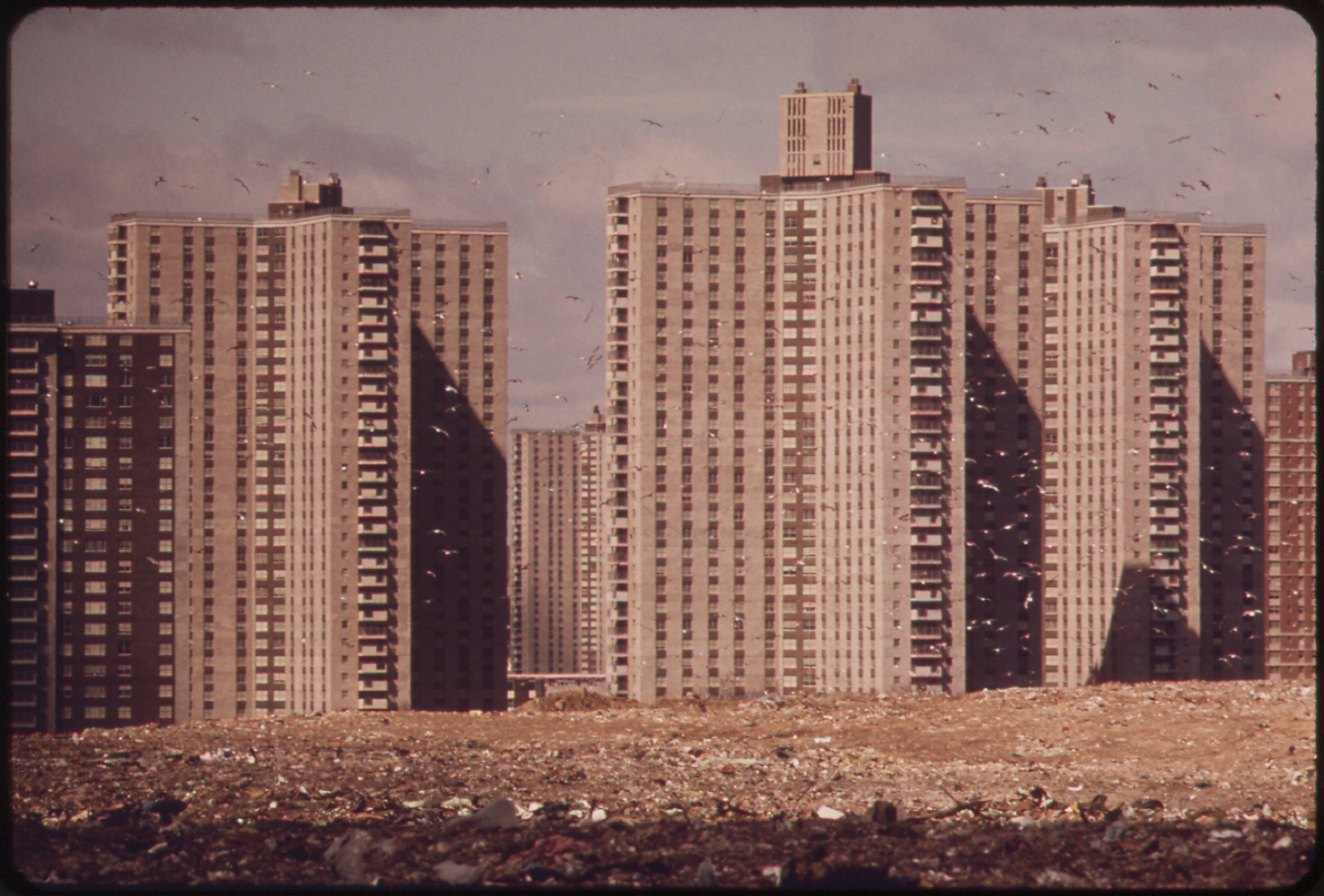Two images underscored the paradox and pain of Polish Cardinal Jozef Glemp’s controversial visit to the United States.
On Sept. 25, under a gray sky and persistent drizzle, Cardinal Glemp, escorted by Albany Bishop Howard Hubbard and ringed by a dozen reporters, approached the cathedral for what would be a terse ceremony with local Jewish leaders.
5A moment of confusion ensued as a large woman in a black hat and coat lunged for the cardinal, trying to thrust what looked like an envelope into his hands. She did not succeed, and the cardinal proceeded up the cathedral stairs.
The woman was a court officer who had failed to serve the cardinal with a summons stemming from a civil defamation suit filed by a Bronx rabbi. It was the latest chapter in a conflict involving a controversial Carmelite convent located near the Auschwitz concentration camp in Poland.
 Later that evening, in a working-class neighborhood in nearby Schenectady, nearly 500 Poles—many who had come from distant points in New York and New England—gathered at a Polish church where Cardinal Glemp was to celebrate Vespers. Little girls were dressed in traditional Polish costumes, with wild flowers braided in their hair; uniformed men, some with “Solidarity” pins in their lapels, marched bearing standards proclaiming faith in Jesus Christ and Our Lady of Czestochowa; the sound of joyous folk hymns filled the air.
Later that evening, in a working-class neighborhood in nearby Schenectady, nearly 500 Poles—many who had come from distant points in New York and New England—gathered at a Polish church where Cardinal Glemp was to celebrate Vespers. Little girls were dressed in traditional Polish costumes, with wild flowers braided in their hair; uniformed men, some with “Solidarity” pins in their lapels, marched bearing standards proclaiming faith in Jesus Christ and Our Lady of Czestochowa; the sound of joyous folk hymns filled the air.
They listened raptly as the primate of Poland’s Catholic Church delivered his homily in plain, everyday Polish. The words he chose and the images he used reminded them that he was a poor salt miner’s son, one who at 61 had witnessed much hardship during the successive occupations of his homeland by German Nazis and Soviet communists. His talk moved some to tears, and afterward they lined up to thank him for coming.
The local television news that night carried footage from the Vespers service. But the story was not about Poles and their spiritual leader; it was about the court summons.
The press gave full coverage to the views of the plaintiff, Rabbi Avi Weiss. In 1989, Rabbi Weiss and six other Jews entered the convent grounds to protest the fact that the convent had not been moved farther away from the camp as agreed to by a high–level Catholic–Jewish commission a few years earlier.
After the incident, in which Polish workers at the convent physically rebuffed Rabbi Weiss’s group, Cardinal Glemp suggested in a homily that the intruders might have killed the nuns living in the convent had they not been restrained. Moreover, he made reference to the Jewish “power” in the international media as well as to claims that Jews spread alcoholism and communism in Poland. ‘Christianizing’ the holocaust?
Although the convent is now being relocated, Rabbi Weiss recently sued the cardinal for slander because of the homily comments.
In Albany, Rabbi Weiss told reporters that the Vatican built the convent at Auschwitz as part of its “hidden agenda” to “Christianize” the Jewish Holocaust. His counsel, the noted Harvard lawyer Alan Dershowitz, said Catholics ought to be ashamed to have “a bigot” like Cardinal Glemp among “the princes of the Church.”
The drama of Cardinal Glemp’s visit to Albany was symptomatic of the problems that dogged him throughout his recent three–week tour of America. In each of the 14 cities he visited, his concerns about Poland and its people were obscured by the controversy.
While the press reported almost exclusively on the aftermath of the convent, for many Polish Americans the significance of Cardinal Glemp’s first visit to the United States was that it came on the heels of communism’s collapse in Europe and at a time when Polish migration to this country has increased steadily.
For Celestine Wrobel, a Polish American living in the economically distressed city of Cohoes, N.Y., the visit stirred memories of her immigrant parents, who taught her the language and customs of their homeland. Today, she continues the beliefs and practices that she learned as a child in her own home.
“My heart is in Poland, and it’s as if I’m a part of them,” she said, adding that her late mother “would be very proud and honored that I met the cardinal.”
Bishop Hubbard of Albany, like other American Church leaders, welcomed Cardinal Glemp as the courageous leader of his country’s opposition to “godless communism” and Poland’s triumph over “tyranny and oppression.”
Cardinal Glemp was acutely sensitive to the needs of the thousands of Poles who have come to America in recent years, Bishop Hubbard said. The cardinal, he explained, fears that these newcomers “tend to be less churched than the previous wave of immigrants,” and might be “particularly prone to the consumerism and materialism of the Western world.”
Some of the Poles were aggravated by the ruckus over the Auschwitz convent. Leonard Roginski, a Polish American Congress representative, spoke for many when he charged that the press had unfairly cast Poles as anti-Semites.
The history of Jews in Poland is more complex and nuanced that that, however, and includes both periods when Poles persecuted Jews and centuries when Poles protected them and encouraged their culture to flourish. It is that long and tangled history—and especially the anguished memory of what Jews call the “shoah” or Holocaust—that lies beneath the surface of the convent debate.
“We’re dealing with a very deep–seated, traumatic situation—the Holocaust,” said Eugene Fisher, who coordinates Catholic-Jewish dialogue for the American bishops. “Two out of every three Jews in the continent of Europe were killed and most of them were killed in Poland. So, the visit of the Polish primate is symbolic in nature, not only for specific things that he said two years ago, but also of all that history.”
Jewish Leaders Divided
Jewish leaders themselves were divided over how to respond to Cardinal Glemp’s visit.
Seymour Reich resigned as head of the International Jewish Committee on Interreligious Consultations because of these divisions. He said that Jewish leaders should not meet with the cardinal until he retracted his “anti-Semitic slurs” and “apologizes.”
But other leaders, such as Rabbi Jack Bemporad of Lawrence, N.Y., said they were satisfied with the cardinal’s repeated expressions of regret for the remarks he made in the 1989 homily.
In meetings with Jewish leaders in Washington, D.C., for example, Cardinal Glemp said that he “regrets sincerely” that he “caused pain to the Jewish community.”
Through “dialogue” with Jews, he added, he now understood that his remarks “were in many aspects based on mistaken information.”
Rabbi Bemporad said that by amplifying Rabbi Weiss’ politics of fear and anger the press gave him a stature that “he simply does not have in the Jewish community.”
“The large majority” of Jews would reject Rabbi Weiss’ militant stance in favor of dialogue with the cardinal and the Polish Church, he added.
He agrees with many Jews and Catholics that Cardinal Glemp’s 1989 homily was “offensive” and repeated anti-Semitic slurs. But he attributed the cardinal’s remarks to his limited contact with Jews, a consequence, he said, of the cardinal having grown up under Nazism and communism.
“What we have with Cardinal Glemp is a job of educating him with regard to who Jews are, their history. And he’s shown himself to be very open to that,” Rabbi Bemporad said.
He pointed to Cardinal Glemp’s concrete proposals for improving relations between Jews and Polish Christians.
“What will be remembered in the future,” Rabbi Bemporad concluded, “will not be Rabbi Weiss picketing outside these meetings, but that the foundations were laid for proper Jewish-Catholic relations in Poland.”
A Rare Interview
The Auschwitz flap seemed far from Cardinal Glemp’s mind as he agreed to a rare interview before leaving Albany. Heretofore, the cardinal had refused all interview requests. His aides, clearly suspicious, sought assurance that the interviewer was Catholic. In addition, they recorded the interview themselves, presumably as a precaution against misquotes.
The cardinal himself spoke quickly and in grave tones about the Polish Church and people and about Eastern Europe’s struggle for rebirth after 75 years of communism.
“In Poland presently, there are unbelievable, remarkable political changes,” he said through an interpreter. “The Church in Poland wishes to teach people that freedom is the freedom to do good.”
Political independence has brought with it an array of moral threats and challenges to Poles—from drug and alcohol abuse, to materialism and consumerism, to “the defense of life from the very beginning,” the cardinal said. The Church, he added, “is working so that it might morally renew the people.”
As one of the few churches in the Soviet bloc to remain strong during communism’s long night, the Polish church feels an obligation to help democratize and spiritually revive European society, the cardinal indicated. He has sent Polish “missionaries” to Byelorussia, Ukraine and elsewhere to help Polish minorities and others. Also, he is working to heal the old breach between the Orthodox and Roman Catholics.
Cardinal Glemp indicated that his meeting with the American bishops and priests gave him fresh insights into how the Church can function in a free society. To the American Church and particularly to “the Polish people who are maintaining our culture” in America, Cardinal Glemp sought in turn to bring a message of hope and perseverance.
His final words in the interview were words of counsel: “Especially, we have to be tenacious, compassionate and prayerful”
Originally published in Our Sunday Visitor (October 20, 1991)
© David Scott, 2005. All rights reserved.


